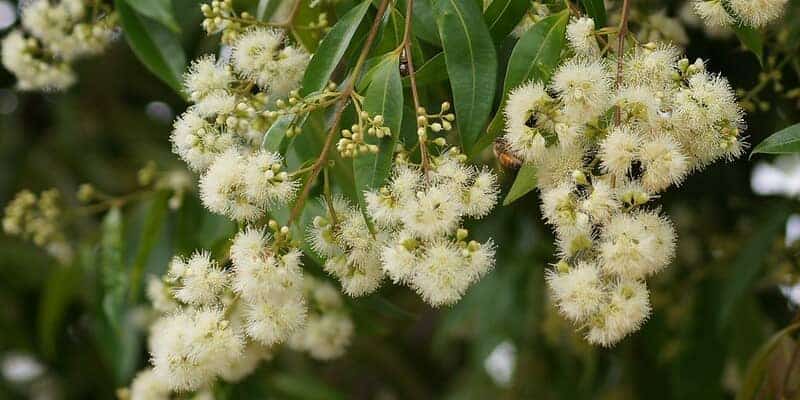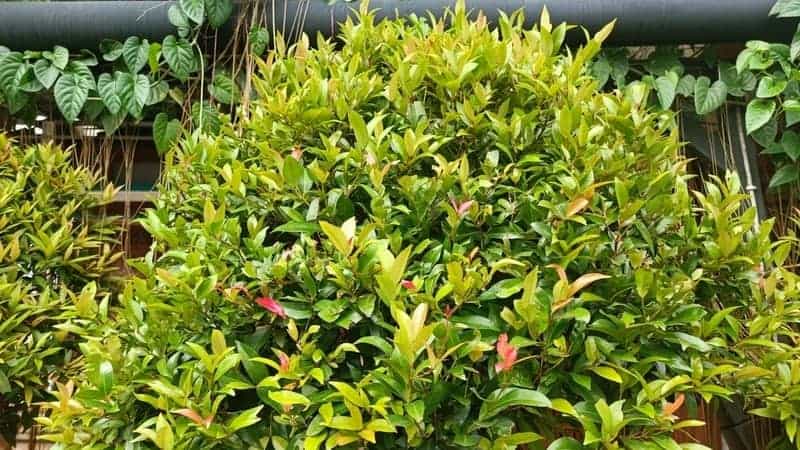Are you looking to brighten up your garden with an Australian native plant?
Why not try a Lilly Pilly?
These evergreen shrubs or small trees have become increasingly popular in Australia due to their beautiful dark green foliage, attractive flowers, and edible red berries.
What is a Lilly Pilly, Anyway?
A Lilly Pilly is an evergreen shrub or small tree native to Australia and Southeast Asia.
Scientifically, Lilly Pillies belong to the Syzygium genus within the Myrtaceae family, including eucalyptus and cloves.
Lilly Pillies are highly versatile and are often used in landscaping and gardening.
They’re best known for their glossy green leaves, fluffy white or greenish flowers, and colourful, edible berries.
Its berries have a tart, crisp taste and can range in colour from white to pink to purplish-red, depending on the species.
Another attractive feature of the Lilly Pilly is its new leaf growth, which can be a range of striking colours from bright pink to a bronzed apricot, depending on the variety.
Lilly Pillies can grow in various sizes and forms, with some varieties maturing into small trees up to 15–30 metres in height, while others are compact shrubs perfect for hedging and topiary.
They’re also quite hardy and resistant to many pests, making them popular for hedging or screening plants.
Types of Lilly Pilly Trees in Australia
Before anything else, there are three main species of Lilly Pilly – Acmena, Syzygium and Waterhousea.
The Acmena tends to have smaller, green leaves and upright foliage. They’re known for their flushes of colourful new growth, ranging from brilliant pink to reddish bronze. They also produce small, white flowers followed by purplish-red fruits.
In contrast, most Syzygium varieties are not as resistant to psyllids. These plants are valued for their dense growth habit, making them excellent for hedging and topiaries.
Then there’s the Waterhousea, which can be recognised by its broad, drooping leaves and lush, evergreen growth. Its attractive pinkish new growth and its graceful, weeping form are highlights for many gardeners.
Now that we’ve covered the basics, let’s talk more about some of the more popular Lilly Pilly varieties.
If you’re on the lookout for a new addition to your garden or you want to have noise-blocking plants, these could be some notable contenders:
Syzygium smithii or Common Lilly Pilly
Acmena smithii ‘Minor’ or Dwarf Lilly Pilly
Waterhousea floribunda or Weeping Lilly Pilly
Syzygium australe ‘Resilience’
Syzygium luehmannii or Small Leaf Lilly Pilly
Syzygium australe ‘Aussie Southern’
Syzygium paniculatum ‘Backyard Bliss’
Syzygium smithii or Common Lilly Pilly
The Common Lilly Pilly is a versatile and attractive plant that offers year-round interest with its evergreen foliage, lovely flowers, and edible fruits.
This plant is characterised by its glossy, dark green leaves. The Common Lilly Pilly also produces clusters of small, white, or cream-coloured flowers in the spring or early summer.
Whether you’re looking for a hedge or screen, the Common Lilly Pilly could be a great choice for your garden as it grows up to 4 metres tall.
Acmena smithii ‘Minor’ or Dwarf Lilly Pilly
The Dwarf Lilly Pilly is an excellent choice for gardeners seeking a low-maintenance, versatile plant with timeless beauty that offers year-round interest.
The defining characteristics of the Dwarf Lilly Pilly are its compact size and dense growth.
Its small, glossy leaves are a vibrant green colour, and the new growth often emerges in a coppery hue before maturing to green, adding an attractive touch to the plant.
The Dwarf Lilly Pilly’s compact size, vibrant foliage, and suitability for various uses, from hedging to container gardening, make it a valuable addition to many garden landscapes.
Waterhousea floribunda or Weeping Lilly Pilly
Waterhousea floribunda is commonly known as the Weeping Lilly Pilly or Rainforest Weeping Lilly Pilly.
It is a beautiful Australian native highly valued for its lush, dense foliage and elegantly weeping branches.
A key feature of the Weeping Lilly Pilly is its white, fluffy flowers, which usually bloom in summer.
The flowers are followed by small, pinkish fruits favoured by various bird species, making it an excellent choice if you’re keen on attracting wildlife to your garden.
Syzygium australe ‘Resilience’
True to its name, this variety is known for its resilience. It is a type of Lilly Pilly that is resistant to psyllids – insects that can cause unsightly bumps on leaves.
Not only does it grow pretty quickly, but the ‘Resilience’ Lilly Pilly is one of the fastest-growing hedge varieties and also has a knack for handling those bothersome psyllids. It only takes about a year and a half for it to reach 2–3 metres tall!
Plus, its new growth emerges in a brilliant red hue – a real eye-catcher.!
Syzygium Luehmannii or Small Leaf Lilly Pilly
As its name suggests, the Small Leaf Lilly Pilly features smaller leaves than many other Lilly Pilly varieties.
Its leaves are glossy and green, and they grow densely, making this plant a terrific choice for hedging and topiaries.
One of the standout features of Syzygium luehmannii is its fruit. The Small Leaf Lilly Pilly produces small, red, elongated berries, also known as “riberries”.
You’ll still get the classic Lilly Pilly berries and white flowers, but it’s a lot more compact and manageable.
Syzygium australe ‘Aussie Southern’
The Aussie Southern is a taller Lilly Pilly variety, growing up to 5 metres.
It’s got these beautiful glossy leaves that range from bright green to a deep, rich burgundy.
If you’re after a high, dense hedge or windbreak, ‘Aussie Southern’ could be your pick.
Syzygium paniculatum ‘Backyard Bliss’
A popular choice due to its fast-growing, compact nature, the ‘Backyard Bliss’ Lilly Pilly has vibrant, glossy leaves with a youthful coppery tone.
This Lilly Pilly variety is also resistant to psyllid attacks, making it a great low maintenance option for your garden.
Syzygium Big Red
The Big Red Lilly Pilly is well-loved for its vibrant new growth, which emerges as a brilliant red and matures to a glossy green.
The tree produces small, creamy white flowers during the summer. Then it grows dark, purplish-red berries.
Syzygium ‘Cascade’
Now, the Cascade Lilly Pilly is a bit special – it’s a hybrid variety of the Weeping Lilly Pilly.
The Cascade Lilly Pilly’s new growth has a lovely pink tinge and has these charming pink pom pom flowers.
If you’re after something with a bit of a wow factor, this Weeping Lilly Pilly might be the one for you.
Syzygium ‘Hinterland Gold’
This variety is a compact, speedy grower with golden-green foliage and a lovely bronze tinge to its new growth.
The ‘Hinterland Gold’ Lilly Pilly is ideal for creating a screen or hedge, and it’s also pretty good at standing up to psyllids.
Syzygium ‘Silver Sheen’
This cultivar is known for its striking, glossy green leaves that shimmer when they catch the light.
It produces small, white fluffy flowers that are typically followed by small, fleshy berries.
The Silver Sheen can reach heights of about 4–8 metres.
Its dense, fast-growing nature makes it excellent for privacy screens, hedges, or windbreaks.
Syzygium Winter Lights
What sets the Winter Lights Lilly Pilly apart is its unique leaf colour. New growths come in an array of warm tones, ranging from pink to a bronzy red.
This variety produces fluffy, creamy white flowers and small, dark reddish-purple berries.
Winter Lights trees have a compact growth habit, making them an ideal screening plant with a height of 3 metres.
Which Lilly Pilly Variety is Best for Your Garden?
While they’re available in many different varieties, not all lilly pilly shrubs are suitable for all regions of Australia.
Lilly Pilly varieties that thrive in coastal regions
If you’re fortunate enough to live near the coast, then there are a few Lilly Pilly shrubs that will love your gardening space.
These include varieties like Syzygium australe, also known as brush cherry. This variety performs well in beachy regions, and its striking purple fruit is a real showstopper.
Other Lilly Pilly varieties suited to coastal areas include Syzygium luehmannii, Syzygium ‘Cascade’ and Syzygium ‘Silver Sheen’.
Lilly Pilly varieties for inland areas
If your outdoor space is located further inland, then there are different Lilly Pilly varieties that are better suited to that region.
One of these is Syzygium ‘Big Red’, which produces deep red new foliage that matures to glossy green.
Another variety that does well in inland areas is Syzygium ’Winter Lights’, which gets its name from its bright red new growth that appears during the wintertime.
Lastly, the Lilly Pilly Resilience is ideal for regions with moderate to low rainfall, as it can withstand some drought.
Lilly Pilly varieties for hedging
Many gardeners choose Lilly Pilly shrubs for hedging purposes because they grow relatively quickly and can be trimmed easily.
If hedging is a priority for you, then there are some Lilly Pilly varieties that are ideal for the task.
The best lilly pilly for hedges is the Syzygium australe, as it can grow up to 4 metres high and has dense foliage that provides an effective barrier.
Syzygium ’Hinterland Gold’ is another variety that performs well as a hedge, offering bright golden new growth that matures to a glossy green.
Lilly Pilly varieties for topiary
For those who enjoy topiary, many Lilly Pilly varieties are better suited to this type of gardening.
One is Syzygium paniculatum, which is known for its dense growth and high bushy habit. Its foliage is bright green, and its small fruit is pale pink.
Another variety that works well for topiary is Syzygium ’Tiny Trev’, which is a low-growing shrub that has small leaves and produces bright red new growth.
Lilly Pilly Care and Maintenance
Whether you’re growing psyllid-resistant varieties or common cultivars, Lilly Pillies will surely add beauty to your garden.
They are also a joy to care for, as Lilly Pillies are a hardy plant and easy to maintain.
These are native Australian flowering plants, after all, so they are used to hot weather conditions.
Prune them to your desired shape and size, or get miniature varieties for a smaller garden space.
One thing to watch out for when growing Lilly Pillies is psyllids. These pests burrow into the leaves of your plants and cause them to look pimply and unsightly.
The best option is to have your Lilly Pillies treated professionally to stop the infestation and prevent further damage.
With some professional pest management and pruning, you’ll surely enjoy having a healthy Lilly Pilly hedge all year round.
Don’t Be Silly, Plant a Lilly Pilly
Bear in mind while Lilly Pillies are hardy, they do have some basic needs to attend to.
Most varieties will prosper in full sun or part shade and require well-drained soil, and regular water, especially during hot weather.
A bit of care can ensure your Lilly Pilly stays in top form.
Whether you’re a seasoned gardener or a novice looking to diversify your yard, these versatile and resilient natives are worth caring for.













